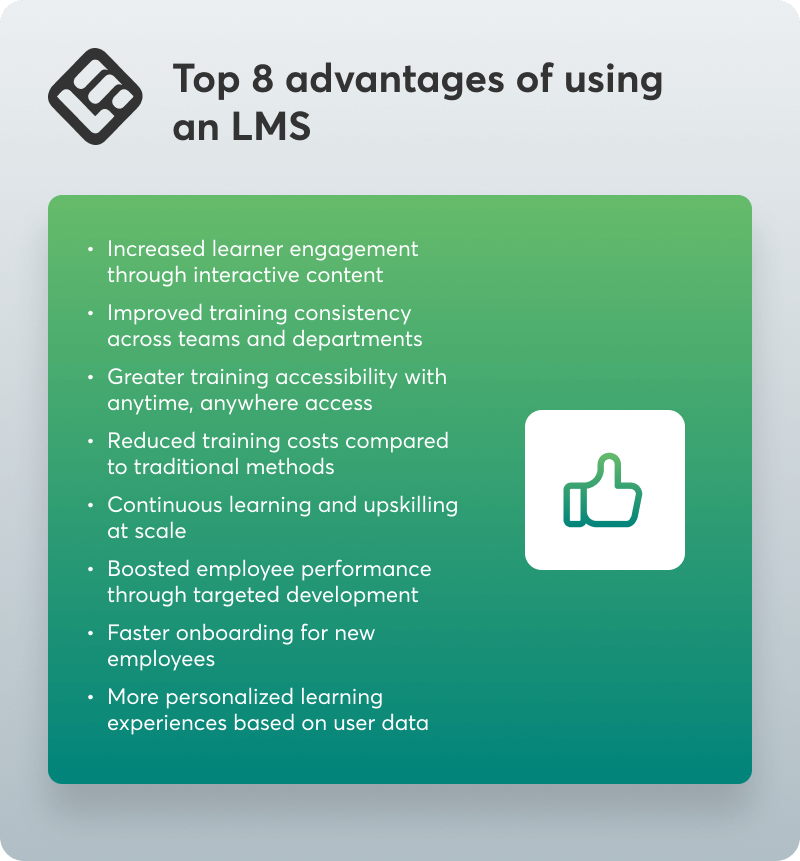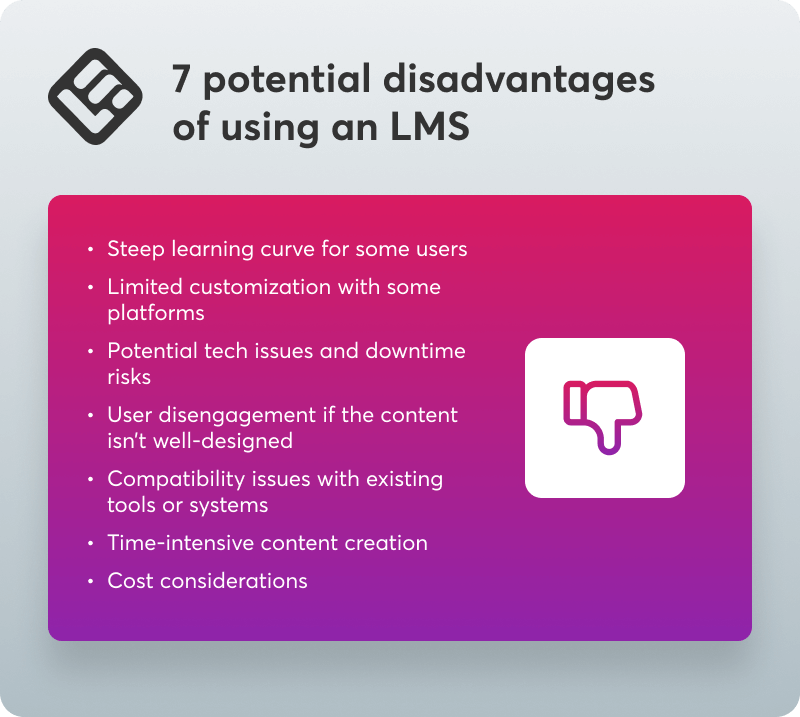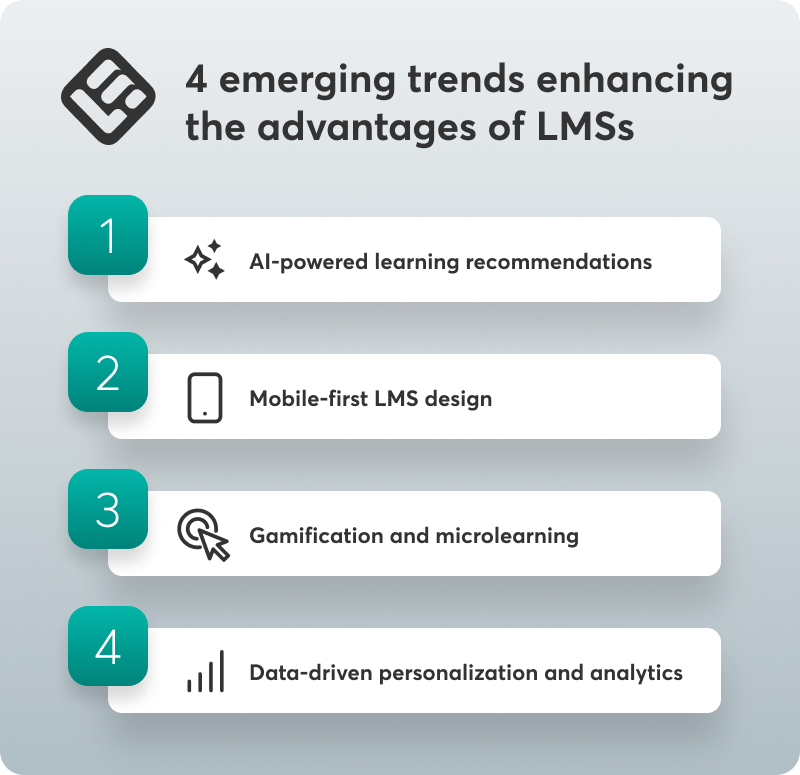Table of Contents
If you think a learning management system is nothing more than a virtual classroom, you’re in for a major surprise.
It’s a living, breathing, ever-changing environment where flexibility and scalability lead the way towards unique learning experiences.
That doesn’t come without its fair share of obstacles.
I’ll help you sort through all that noise so you can understand how LMS platforms can be, at the same time, a game-changer for global learning and a surprising source of complexity. Plus, how to handle all that.
Below is a table summarizing the key pros and cons of using learning management systems.
| Advantages of learning management systems | Learning management system disadvantages | ||
| Centralized and organized educational content management | Steep learning curve for some users | ||
| Scalable for any number of learners and locations | Limited customization with certain platforms | ||
| Flexible, anytime/anywhere access for learners | Potential technical issues and downtime risks | ||
| Cost-effective compared to traditional training | User disengagement if content isn’t engaging | ||
| Personalized learning paths and adaptive delivery | Compatibility issues with existing systems | ||
| Easy progress tracking and analytics | Time-intensive content creation | ||
| Supports continuous learning and upskilling | Ongoing costs for licensing, support, and maintenance | ||
First, let’s start looking into the benefits of learning management systems.
8 benefits of LMS platforms
Learning management systems (LMS) are changing. And so are their benefits and the things they offer.
Back in the day, they were a great solution for content aggregation, flexible learning materials accessibility, and easy use of interactive elements within training programs.
Now they do so much more by providing the following advantages.

1. Increased learner engagement through interactive content
LMS platforms give teachers and trainers the ability to integrate multimedia, gamification, quizzes, and collaborative project work into their online training.
Among others, I’ve noticed that whenever you bring video-based modules and live discussion forums to an onboarding plan, new hires become more engaged and retain more knowledge.
Engaging training materials are best used for grabbing attention. They also support diverse learning styles, thus establishing a lasting relationship between students and the content. That’s perfect for social learning.
2. Improved training consistency across teams and departments
One of the greatest things about LMS implementation is that it lets you provide consistent learning quality to all employees regardless of location or training needs.
Consistency is the biggest advantage of using an LMS. It allows you to deliver the same experience every time, whether you are onboarding staff, training clients, or delivering professional development. An LMS offers a consistently structured, trackable, and scalable experience. Additionally, an LMS identifies where learners are struggling, you can improve the content or offer extra support.
Pushing out mandatory training, for instance, via the right learning management systems gives everyone the exact same content and assessments/results.
3. Greater training accessibility with anytime, anywhere access
LMS systems also allow people with different learning styles to overcome learning hurdles.
Having the ability to streamline training and education within an organization to one platform is a game changer. The centralization of resources and tracking progress is invaluable in upskilling or training. An LMS allows you to do precisely this, keeping all training and relevant documentation all in one place.
With 24/7 access to the learning materials, this LMS flexibility means anyone can study at their own pace, using the exact formats they prefer, without having to struggle with juggling between multiple priorities.
4. Reduced training costs compared to traditional methods
An online educational platform reduces travel costs, venue hire costs, and ongoing administrative costs by digitizing content and automatic bureaucratic tasks.
This makes training easier to scale, even if you don’t have a huge budget. Not to mention that with cost-effectiveness in mind, everything you save can go towards more content development and employee incentives.
5. Continuous learning and upskilling at scale
LMS systems are also good if you want to provide lifelong learning in your workplace.
It’s easy to update existing educational courses and release new modules whenever new skills are needed. So it’s easy for employees to make the most out of every opportunity to stay afloat, no matter how competitive the market may be.
6. Boosted employee performance through targeted development
Strong analytics and unique learning paths. That’s all you need to identify skill gaps and create customized training opportunities.
Managers can also use an LMS to monitor progress and step in to offer support where it is necessary. For example, you can use it to customize leadership development programs for high-potential employees, a change that can have a huge and immediate impact on performance.
7. Faster onboarding for new employees
Many learning management systems make onboarding easier. This means new employees can start their jobs with organized learning paths that tell them everything from day one.
This cuts down on the time, resources, and staff required for in-person training. It also almost guarantees all new employees have a common understanding of company culture, policies, and procedures.
LMS has the potential to completely transform training efficiency, making content centrally accessible as well as the progress of learners easier to track. Businesses can have a good insight into the effectiveness of training with automated assessments and reports on performance. It enables businesses to provide scalable training that can be accessed by many people, saves them time, and administrative activities by up to 50%.
Wagamama slashed their annual training costs when they decided to switch LMS provider and use LearnWorlds instead. With the cost-per-employee now being almost negligible since they can virtually train hundreds of employees, they also no longer need to pay extra for printing training materials and face-to-face sessions.
8. More personalized learning experiences based on user data
Advanced LMS solutions analyze user data to automatically personalize learning paths, recommend the right content, and change assessments based on how a learner progresses.
According to McKinsey, companies that reimagine the learning process by using AI for personalization can see employee engagement go as high as 50%, training costs being cut by 50%, and productivity accelerated by as much as 40%.
But there must be something challenging behind all the benefits, right?
7 learning management system disadvantages
Drawbacks are likely to happen, but when you prepare, you can make the most out of a learning management system.
Here are seven of the biggest drawbacks to LMS software, with a closer look at each.

1. Steep learning curve for some users
Many LMS tools can force users to learn new interfaces and even completely change the way they work. For professions less comfortable with digital tools or organizations that don’t provide a robust onboarding process or a user-friendly dashboard, this learning curve can be difficult.
The user experience is not always considered during the design of the systems, and employees might have difficulties with using a complicated interface, particularly when they do not know anything about technology. Information overload is also a threat, since employees can end up with a huge amount of content that would be too much to handle without proper direction.
2. Limited customization with some platforms
Although easy to use, LMS solutions can come with customization limitations. It can be challenging for organizations to customize the platform to their branding, workflow, or unique training requirements every time.
So you need deep customization capabilities and integrations to support your team, even when you grow. Ideally, without the extra coding needed.
3. Potential tech issues and downtime risks
Like with other tools, LMS systems can experience tech issues such as sluggish loading times, bugs, and even crashes. These performance issues can hamper learning, irritate users, and lower completion rates. So be sure to diagnose and correct these issues before they escalate.
4. User disengagement if the content isn’t well-designed
No matter how good an LMS is, it won’t make up for terrible learning content. So now’s also a good time to re-think your content creation strategy, make it less boring, and, of course, personalize it.
A cluttered LMS may cause disengagement; thus, the content must change at the same pace as the needs of the learners. I have seen companies that, after optimizing their course materials, achieved amazing gains in completion rates. What is necessary is to have a well-planned system as well as attention-grabbing content. The difference between a passive system and an active, powerful system is quality content that is relevant and refreshed on a regular basis. The quality of an LMS is what you make out of it.
5. Compatibility issues with existing tools or systems
Connecting an LMS to the company’s HR, analytics, or communication tools is normally a pretty clear process, but it always takes extra time and resources. That’s why it’s a good idea to pick an LMS that provides industry-accepted data formats you can easily use or APIs strong enough to handle it all.
6. Time-intensive content creation
Back to creating excellent LMS content, well… that’s where you need some more resources. Developing interactive modules, videos, flash animation, or quizzes often involves a team of specialists. This can lead to project delays or strong reliance on external vendors (when you don’t have the in-house expertise or programming knowledge).
Content creation is another hurdle. Quality learning materials take time to develop or require budget allocation if outsourced. Without engaging content, even the best LMS becomes an expensive, underutilized tool.
7. Cost considerations
While LMSs can cut some training costs, you’ll want to be aware of hidden costs vendors don’t always transparently display on their pricing page. These can include unexpected licensing or subscription costs, customization fees, support and maintenance fees, and possible charges for upgrades, storage, or new users.
💡Keep learning: Top 10 learning management systems for 2025
💡Check also the following platform comparisons:
What are the advantages and disadvantages of elearning?
Online learning today almost equates to using an LMS. Students learning online enjoy the flexibility to learn at their own speed, the range of lessons on offer, and the opportunity to slot education around their work and home lives.
When you’re not using an LMS, though, online learning might seem plain and unenticing. Online learning success means learners need a good deal of self-motivation and discipline. Some may also struggle with learning when not interacting with real people or experiencing things hands-on.
Tactical and technical obstacles such as these are common when learning is conveyed in simple videos you share on YouTube or mere downloadable guides. That’s exactly what we’re fighting with an LMS.
Here’s a complete look at the advantages vs. disadvantages of elearning.
| Elearning advantages | Elearning disadvantages | ||
| Flexible, self-paced learning to study anytime, anywhere | Requires strong self-motivation and discipline | ||
| Wide variety of courses and resources available online | Limited social interaction and potential for isolation | ||
| Reduces travel and material expenses | Technical issues and the need for reliable internet access | ||
| Personalized learning paths and accessibility for diverse needs | Difficult to teach/practice hands-on or soft skills online | ||
| Immediate feedback and progress tracking | Content can become outdated or lack accreditation | ||
| Scalable for organizations and institutions | Increased screen time and potential for distractions | ||
| Supports various learning styles | Quality varies, as you won’t always have the best instructors or content | ||
💡Keep learning: What is online learning? Brief history, benefits, and limitations
Emerging trends that enhance the advantages of learning management systems
The following trends impact both elearning and the way we use an LMS.

AI-powered learning recommendations
AI now makes it possible to adapt learning paths and recommend content based on your learners’ exact needs and preferences. AI models study student behaviour, results, and likes to suggest tailored course recommendations, adapt them based on difficulty level, and even offer instant feedback.
LearnWorlds makes use of AI for this, so you can share the right courses and provide learning paths that adapt to what learners truly need.
Mobile-first LMS design
Got remote workers? Or maybe you just want to support new hires with on-the-go learning?
Mobile-friendly platforms make it easy for students to start a course on a laptop and pick it up from their phone as they commute or while they wait in line for their coffee.
That kind of flexibility is a goldmine for field workers or staff with irregular schedules.
Gamification and microlearning
When I say gamification, I mean points, badges, leaderboards, and a dash of microlearning. These are the most common ready-made gamification features you’ll find in the best LMS tools out there.
But gamification is what you make it. So in the future, you can expect learning tools to get more creative. For example, scenario-based simulations and game mechanics are expected to foster friendly competition and real-time feedback to engage learners in a game-like environment and improve knowledge retention.
Data-driven personalization and analytics
Like artificial intelligence, analytics can also recommend related courses, surface learners in need of attention, and advise you on how to improve your curricula.
With advanced analytics, LearnWorlds lets you monitor and measure learner progress, knowledge gaps, and customize the learning journey.
LMS pros and cons: How to select the right system for your business
Now’s the time to weigh up your LMS options in just a couple of steps. Here’s a quick 7-step guide to help you.
💡 Read also: How to choose the best learning management software for your business in 2025
Get all the benefits of learning management systems with LearnWorlds
Find out what an LMS enables you to do given your existing needs and objectives. With LearnWorlds, you can do all the following for your business:
Ready to find out how LearnWorlds can speed up training and grow your team? Get your free trial to discover the possibilities.

Alexandra Cote
Alexandra Cote is a SaaS growth marketer and online instructor who's worked with dozens of brands in the MarTech, HR tech, and productivity space. She's also a strong supporter of staying happy at work and choosing a healthy career path.
FAQ
Everything you have ever wondered, but were too afraid to ask...




